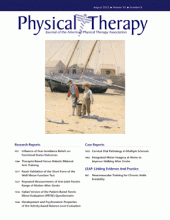Abstract
Background A paucity of information exists on the psychometric properties of several balance outcome measures. With the exception of the Modified Functional Reach Test, none of these balance outcome measures were developed specifically for the population with spinal cord injury (SCI). A new balance assessment tool for people with SCI, the Activity-based Balance Level Evaluation (ABLE scale), was developed and tested.
Objective The purposes of this study were: (1) to develop a scale capturing the wide spectrum of functional ability following SCI and (2) to assess the initial psychometric properties of the scale using a Rasch analysis.
Design A methodological research design was used to test the initial psychometric properties of the ABLE scale.
Methods The Delphi technique was used to establish the original 28-item ABLE scale. People with SCI at each of 4 centers (n=104) were evaluated using the ABLE scale. A Rasch analysis was conducted to test for targeting, item difficulty, item bias, and unidimensionality. An analysis of variance was completed to test for discriminant validity.
Results The Rasch analysis revealed a scale with minimal floor and ceiling effects and a wide range of item difficulty capturing the large scope of functional capacity after SCI. Multiple redundancies of item difficulty were observed.
Limitations All raters were experienced physical therapists, which may have skewed the results. The sample size of 104 participants precluded a principal component analysis.
Conclusion Development of an all-inclusive clinical instrument assessing balance in the SCI population was accomplished using the Delphi technique. Modifications of the ABLE scale based on the Rasch analysis yielded a 28-item scale with minimal floor or ceiling effects. Larger studies using the revised scale and factor analyses are necessary to establish unidimensionality and reduction of the total item number.
Footnotes
Dr Ardolino, Dr Hutchinson, Dr Pinto Zipp, and Dr Harkema provided concept/idea/research design. Dr Ardolino, Dr Hutchinson, Dr Pinto Zipp, and Dr Clark provided writing and data analysis. Dr Ardolino and Dr Harkema provided data collection. Dr Ardolino provided project management. Dr Harkema provided study participants. Dr Clark and Dr Harkema provided institutional liaisons. Dr Hutchinson and Dr Clark provided consultation (including review of manuscript before submission).
The authors thank the staff and patients at Magee Rehabilitation, the Shepherd Center, Kessler Rehabilitation, and Frazier Rehabilitation for their time and participation in this study. They also thank the Balance Committee of the NeuroRecovery Network for their assistance in initiating the development of the ABLE scale.
Approval for the study was granted by the institutional review boards of Magee Rehabilitation Hospital, Shepherd Center, Kessler Research Center, Frazier Rehabilitation Institute, and Seton Hall University.
- Received August 12, 2011.
- Accepted May 3, 2012.












